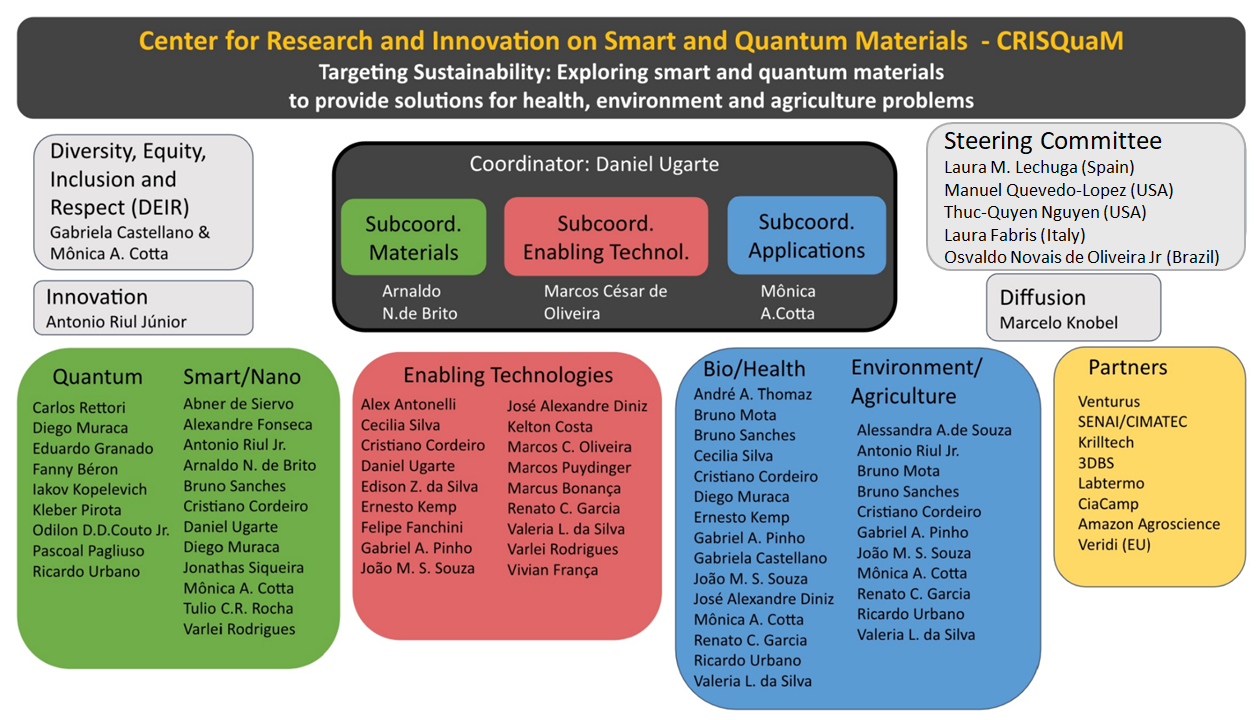BV-FAPESP: research projects supported in this Center
CRISQuaM in the Media: news about the center
CRISQuaM aims to explore the synergistic development of fundamental and applied science to create new materials with high potential for the construction of devices and sensors to address technological challenges related to sustainability, climate change, precision agriculture, ecology, and health. To achieve these goals, we have assembled an interdisciplinary and collaborative research team, integrating expertise across various scientific domains, researching novel materials with high innovation potential. By combining original synthesis methods, advanced characterization techniques, theoretical approaches, computational simulations, quantum technologies, and device construction designs, we aim to drive advances in smart and quantum materials, promoting scientific excellence and technological development. With this, we plan disruptive innovations in instrumentation—including hardware and AI-based tools—as well as in quantum technologies, biomedical devices, and signal processing, in addition to plant bionics, exploring plant-pathogen interactions. Besides research activities, we plan intensive actions in education, dissemination, and communication for the general public, as a modern society should be aware of the challenges humanity faces and how research and technology are essential for responsibly utilizing the planet's limited resources. CRISQuaM's Innovation activities are accelerated through partnerships with several companies in related technologies, many of them Brazilian. Finally, all activities of the Center are managed in accordance with diversity, equity, and inclusion goals and best practices.
The Center brings together scientists, engineers, and innovators in a collaborative effort to apply materials science and quantum technologies at the cutting edge, designing new materials and nano(bio)sensors for advanced diagnostics. The Center has a team capable of producing a wide range of (nano/micro) materials, along with precise chemical and physical characterizations using modern techniques (synchrotron, advanced microscopy, magnetotransport, magnetic resonance, optics, etc.). In addition, the team offers various options in enabling technologies, including miniaturization, processing, and additive manufacturing, as well as instrumentation, quantum sensing, and electronics development. Data analysis will employ updated approaches (numerical simulation, classical and quantum machine learning, and quantum optimization). Applications at the knowledge frontier will address urgent sustainability needs in environmental areas, precision agriculture, plant bionics, and biomedical interfaces, contributing to the development of local technologies in close partnership with the Brazilian industry.
The organization of the Center is based on three pillars — Materials, Enabling Technologies, and Applications — together with partner companies, as described in the figure below.

2024-03-20
More than 29 thousand patients were analyzed and 26 areas of the genome associated with the disorder were identified; Brazil was the only Latin American representative through the Brazilian Institute of Neuroscience and Neurotechnology of the State University of Campinas.
2024-03-20
Created at a FAPESP-supported research center, the material helps produce ammonia by electrochemical reduction of nitrogen gas, dispensing with the high temperature and pressure required by the conventional method.
2024-03-20
Researchers at the University of São Paulo in Brazil compared data for the immune response induced by natural infection and vaccines. They identified the key factors in the development of long-lasting immunity. Their findings can be used to develop novel vaccines and antiviral therapies.
2024-03-20
SyncLight 2024 will discuss the recent opportunities offered by advanced experimental synchrotron techniques available at Sirius, the Brazilian 4th generation light source.
2024-03-20
An analysis of occurrence records for ten lizard and snake species found in three South American biomes – the Caatinga and Cerrado in Brazil and the Chaco in Argentina and Paraguay – showed that rising temperatures in the coming decades could lead to extinction in some cases and drastic habitat loss in others. The authors advocate an increase in full-protection conservation units suited to these animals.
2024-03-13
Farmers in the Paraíba Valley region of São Paulo state received economic incentives such as payment for environmental services to adopt conservation practices and protect native vegetation.